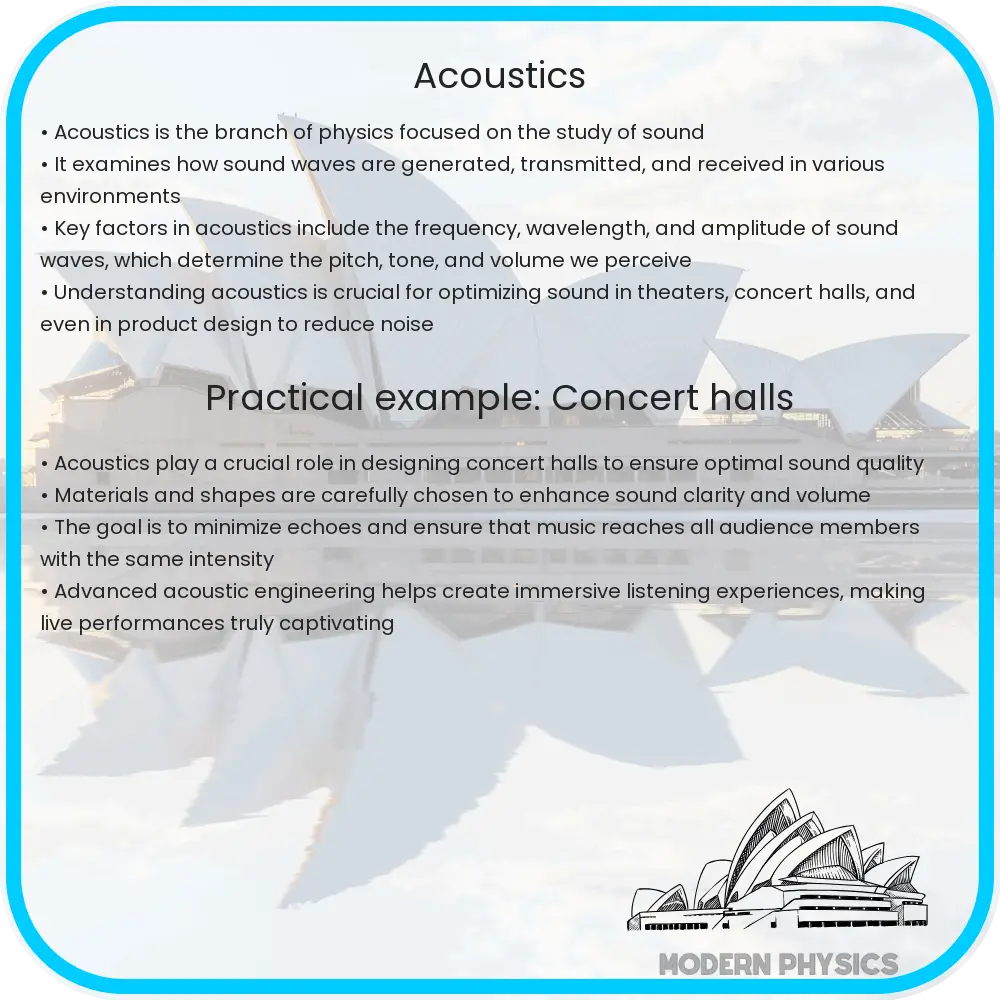Acoustics is the branch of physics focused on the study of mechanical waves in gases, liquids, and solids, covering sound production, transmission, perception, and vibration analysis.

Introduction to Acoustics: Understanding Sound and Vibration
Acoustics is the branch of physics that deals with the study of all mechanical waves in gases, liquids, and solids including topics such as vibration, sound, ultrasound, and infrasound. This field encompasses not only how sound is produced, transmitted, and received but also how it is perceived by humans. Let’s dive into the fundamentals of acoustics, covering sound, vibration, and audio analysis.
What is Sound?
Sound is a type of energy that is made by vibrations. When any object vibrates, it causes the air around it to also move. This movement of air particles creates what we know as sound waves, which can travel through different mediums including gases, liquids, and solids. The basic properties of sound waves include frequency, wavelength, amplitude, speed, and timbre.
Frequency and Pitch
The frequency of a sound wave refers to the number of vibrations per second and is measured in hertz (Hz). It is directly related to the pitch that we hear; a higher frequency means a higher pitch. For example, the note A above middle C in standard musical tuning vibrates at 440 Hz.
Wavelength and Amplitude
Wavelength is the distance between identical points in the adjacent cycles of a waveform, and it is inversely proportional to frequency. The amplitude of a sound wave determines its loudness; greater amplitude results in a sound that is perceived as louder.
Speed of Sound
The speed of sound is how fast a sound wave travels through a medium and it varies depending on the medium and its conditions. For instance, in dry air at 20 degrees Celsius, sound travels at approximately 343 meters per second (m/s).
Understanding Vibration
Vibration is the back and forth movement of an object from its position of rest. This mechanical oscillation can occur in various settings and is the source of all sound waves when it occurs in a medium capable of transmitting these waves. Vibration in objects can be desired, as in the case of a tuned guitar string, or undesired, such as the vibrations in a moving vehicle.
Basic Audio Analysis
Audio analysis involves breaking down sound into its constituent components to assess or manipulate these components. This can involve measuring sound levels, frequency content, and duration among other aspects. Technologies such as Fourier transform are commonly used to transform time-based sound signals into their frequency components for easier analysis.
- Intensity: Describes the energy of the sound wave and is measured in decibels (dB).
- Spectrum: Illustrates the different frequencies present in a sound.
- Oscillograms: These are visual representations of how sound waveforms change over time.
Understanding these fundamentals helps in various applications, from designing quieter machines to creating better sound systems and improving noise control strategies.
Applications of Acoustics
Acoustics has far-reaching applications across many fields. In architecture and building design, acoustical engineering is utilized to enhance sound quality in theaters and auditoriums, and to minimize noise in residential and office spaces. In the medical field, ultrasound technology, a branch of acoustics, enables detailed imaging of the human body, aiding in diagnostics and treatment. Environmental acoustics aims to understand and control noise pollution in urban environments, promoting healthier living spaces.
Human Perception of Sound
The way humans perceive sound involves both physical and psychological processes. The ear captures sound waves, transforming them into electrical signals that the brain interprets. Factors such as age, health of the auditory system, and exposure to noise can affect how we perceive sounds. Understanding these facets is vital for designing hearing aids, developing better communication devices, and improving public alert systems.
- Hearing Loss: Prolonged exposure to high decibel levels can lead to permanent damage of the inner ear.
- Psychoacoustics: This field studies the psychological responses associated with sound, including why certain sounds elicit emotional responses.
Conclusion
Acoustics, the science of sound, plays an integral role in various aspects of daily life and technology. From enhancing the sound in performance spaces to diagnosing medical conditions with ultrasound, the applications are vast and vital. Understanding the basics of sound waves, from their creation through vibration to how they are perceived by the human ear, allows for advancements in technology and improvements in quality of life. By exploring the principles of acoustics, we gain insight into a fundamental aspect of our interaction with the world around us. Whether it’s through designing quieter appliances, creating richer soundscapes, or protecting our hearing, the knowledge of acoustics enriches our experiences and bolsters our interactions within our environments.
